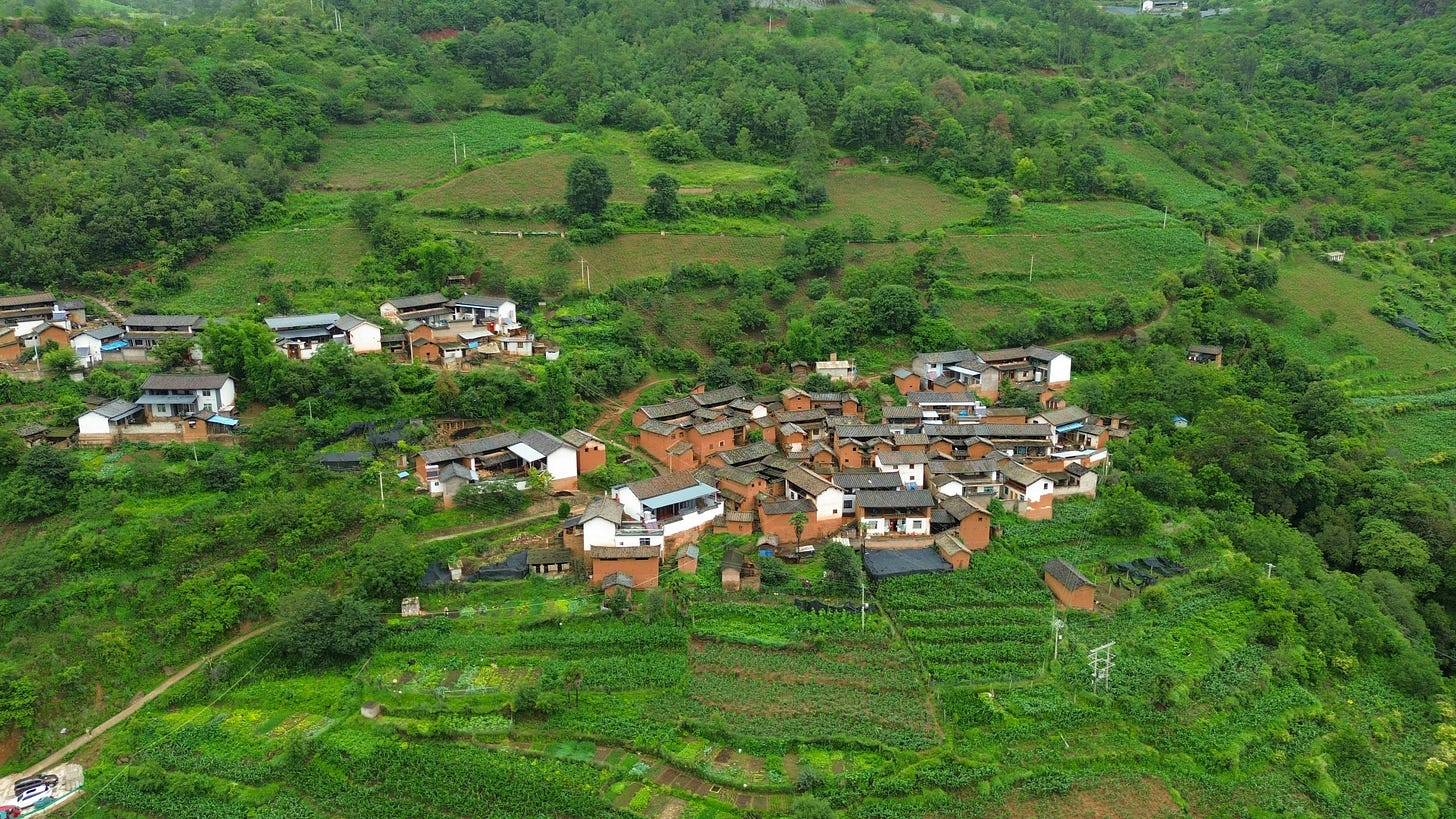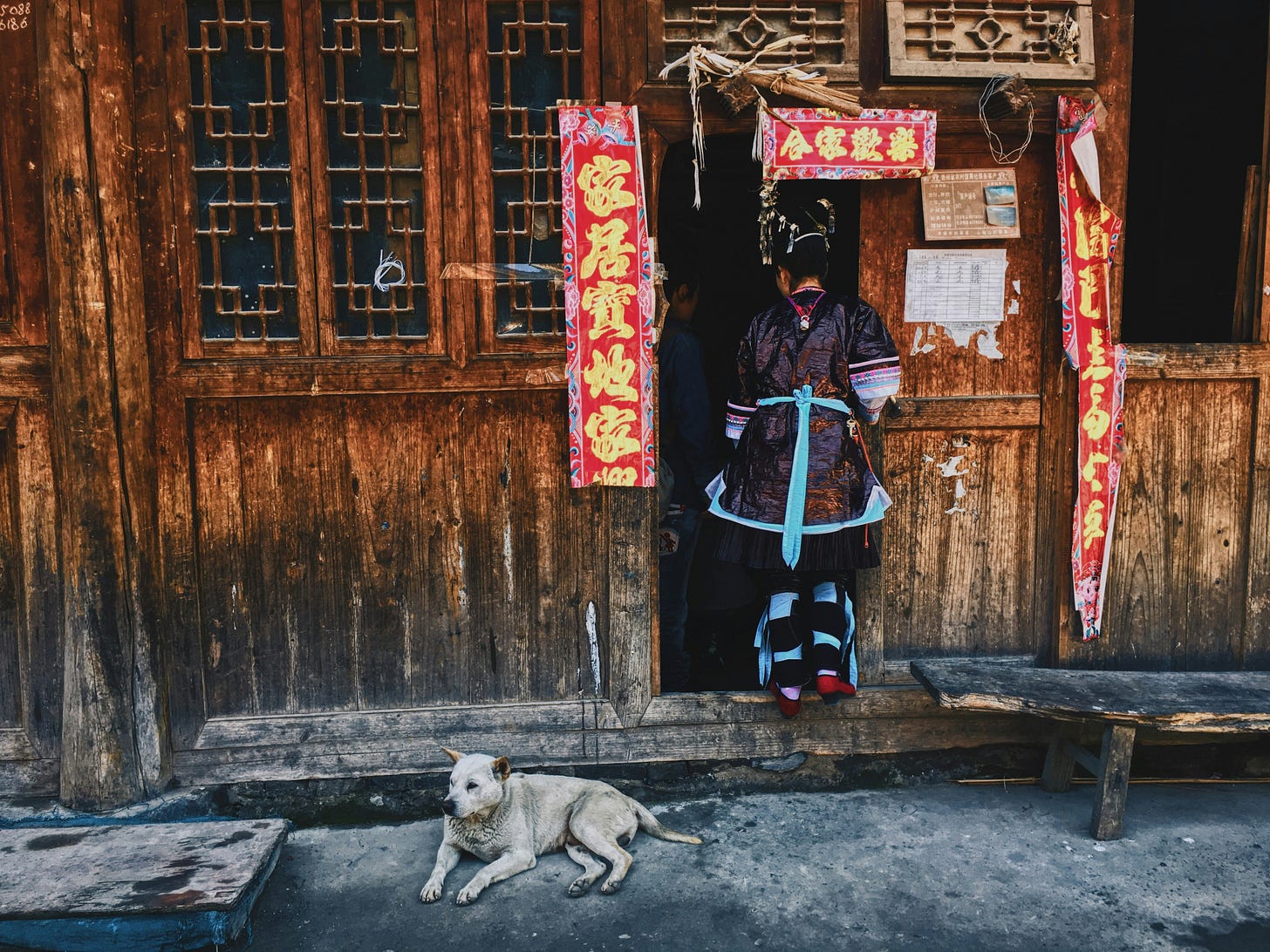Woodcutting in Yunnan: Tradition, Policy, and Ecological Impact
Exploring the Interplay of Cultural Rituals, State Policies, and Environmental Sustainability in Yunnan’s Mountain Villages
In the remote mountain villages of Yunnan Province, woodcutting is far more than a practical necessity—it is a tradition intricately tied to survival, spirituality, and the cultural identity of its diverse peoples. For centuries, these practices have sustained communities across the ecologically rich landscapes of southwestern China. Woodcutting provides essential resources like fuel, building materials, and even medicinal plants, but it is also a profoundly spiritual act. Rooted in local belief systems, it embodies an ecological wisdom that links human life with nature. However, this tradition faces growing challenges from state policies and environmental changes.
In our story last week about staying warm in rural China, we touched on how wood is a crucial resource for heating, especially in the southern regions where winters, though milder than in the north, can still bite with their damp chill. This connection between wood and warmth is particularly evident in Yunnan’s rural communities, where woodcutting provides not just heat but a means of sustaining life itself. Yunnan Province, known for its rugged mountains, lush valleys, and extraordinary biodiversity, is home to over 25 ethnic groups, each with unique customs. Among them, the Naxi (纳西), Yi (彝), and Hani (哈尼) peoples stand out for their close ties to the land and the woodcutting traditions that remain central to their lives.
In the remote villages of these communities, woodcutting is not merely a task for survival—it is a sacred act performed to honour the spirits of the land and preserve ancestral knowledge. These ceremonies transcend utility, embodying a cultural heritage that has harmonised human and ecological needs for generations.
The Naxi People of Lijiang: Spiritual Acts of Reciprocity
The Naxi people, primarily concentrated in the Lijiang region of Yunnan Province, are famed for their deep spiritual connection to the land, reflected in their unique woodcutting traditions. Centred around ancient towns like Baisha and Yuhu, they inhabit a landscape of verdant valleys, pristine rivers, and the sacred Jade Dragon Snow Mountain (玉龙雪山), which looms as a guardian over their communities. The Naxi culture blends an animistic worldview with influences from Tibetan Buddhism and Taoism, forming a reverence for nature that permeates their daily lives and practices.
Before any tree is cut, a community-led ritual underscores the Naxi’s belief in maintaining harmony with the natural world. This ritual, presided over by the mùjiàng (木匠), or chief woodcutter, is a solemn act of respect for Jishan Shen (积善神), the mountain god who governs the forests, rivers, and the well-being of the people. The ceremony often takes place at the tree’s base to be felled. It includes offerings such as rice, tea, incense, and occasionally the symbolic sacrifice of a chicken or goat. These acts are not mere traditions; they request permission and blessings from the divine. The cutting itself is seen as a transaction with the spiritual forces that sustain the community, emphasising reciprocity rather than exploitation.
This intricate spiritual practice is tied to the Naxi’s broader ecological ethos. The Naxi follow a sustainable approach to forest management, ensuring that only mature trees are selected for cutting and encouraging replanting to maintain balance. This sense of stewardship is also embedded in their Dongba script and teachings, a pictographic writing system unique to the Naxi people. The Dongba manuscripts, preserved over centuries, contain prayers, ecological wisdom, and instructions on living harmoniously with nature, including the appropriate times and methods for woodcutting.
For the Naxi, woodcutting extends beyond its immediate utility for building homes, crafting tools, or providing fuel. It is an act of spiritual significance, symbolising their connection to the cycles of nature and the divine. The enduring practice of honouring the land through ceremony and ecological mindfulness has not only sustained their forests but also preserved their cultural identity amid the rapid changes brought by modernisation.
The Yi People of Northern Yunnan: Celebrating Community and Ecological Wisdom
The Yi people, one of Yunnan’s largest and most culturally rich ethnic groups, share a strong spiritual connection with the forests that sustain their communities. Spanning the rugged northern regions of the province, particularly around Zhaotong, the Yi regard the forest as both a vital resource and a sacred entity imbued with animistic spirits. Their woodcutting traditions, steeped in reverence and ecological awareness, culminate in the vibrant and symbolic Woodcutting Festival—a celebration that blends work, spirituality, and communal harmony.
The Woodcutting Festival, held annually, is a cornerstone of Yi cultural identity. During this event, young men and women showcase their strength and skill in a friendly competition to cut the most wood. But beyond the surface of competition, the festival celebrates unity, resilience, and the community’s shared reliance on the forest. The day is filled with lively music played on traditional instruments, energetic dancing, and the preparation of a communal feast that brings the entire village together. For the Yi, this is not just a practical gathering but a moment to reinforce their collective bond and mutual dependence on the land.
Embedded within the festival are solemn rituals led by village elders, who serve as the spiritual guardians of the community. These elders offer prayers and sacrifices to Mùshēng (木生, the forest deity), petitioning for the woodcutters’ safety and the continued vitality of the forest. These rituals symbolise the balance between taking from and giving back to the land, emphasising the Yi’s animistic belief that the forest is a living, sacred entity deserving of respect and gratitude.
A sustainable ethos deeply informs the Yi’s woodcutting practices. Selective logging is strictly observed, with trees chosen based on age, health, and the forest’s overall condition. Certain areas of the forest, particularly those near sacred water sources or believed to house powerful spirits, are strictly off-limits to logging—a practice reinforced by deeply held taboos. These traditions passed down through oral histories and everyday practices, demonstrate an intuitive ecological wisdom that has allowed the Yi to preserve their environment for generations.
However, the Yi’s ancestral practices are not without challenges. As external pressures, including modernisation, resource exploitation, and state policies, encroach upon their traditional way of life, the delicate balance they have maintained with their environment grows increasingly fragile. Yet the resilience of the Yi people, embodied in events like the Woodcutting Festival and their unwavering reverence for the forest, remains a testament to their enduring ecological wisdom and cultural identity.

The Hani People: Woodcutting in Harmony with Agriculture and the Land
The Hani people, residing around the famed Honghe Hani Rice Terraces in southern Yunnan, offer another striking example of how woodcutting is woven into daily life. Renowned for their agricultural expertise, the Hani have developed intricate irrigation systems, where wood plays a critical role in constructing the channels that guide water to the terraces. The terraces, an engineering marvel, are carved into the steep hillsides, and water flow through these channels is essential for their success. In this way, woodcutting supports not only the daily needs of the community but also sustains their agricultural practices, ensuring the survival of the rice cultivation that forms the backbone of their economy and culture.
The Hani’s woodcutting ritual, Qùxī (取西, “to take from the west”), is performed before the cutting season begins. This prayer to the spirits of the river that nourishes their rice fields ensures the flow of water and the harvest’s success. The ritual, imbued with deep symbolism, invokes the river’s spirit to bless the land and the people, reinforcing the connection between the Hani and the natural world. Like the Naxi and Yi, the Hani view woodcutting as a sacred act that honours the natural world and acknowledges the spiritual forces at play in their daily lives.
Like the Yi and Naxi, the Hani adhere to sustainable logging practices. They select specific trees based on age and health, ensuring the long-term vitality of the forest. Sacred areas, particularly those near water sources or significant cultural sites, are carefully protected, and the practice of logging is guided by ancestral wisdom that honours the forest’s role in their survival. Through these practices, the Hani maintain a harmonious relationship with their environment, ensuring that their agricultural systems, reliant on both wood and water, remain in balance.

Shared Traditions, Common Struggles, and the Path Forward
Despite their distinct rituals, the Naxi, Yi, and Hani peoples share a deep respect for nature and an understanding of the balance required for sustainable living. Their woodcutting practices are not merely utilitarian; they are acts of reciprocity where communities honour their harmonious relationship with the land and its spirits. These traditions reflect an intrinsic respect for the environment, ensuring that the land is preserved and respected as part of their spiritual and ecological wisdom.
However, these practices are increasingly under threat as modernisation spreads. Over time, state policies like logging restrictions and afforestation projects have disrupted traditional woodcutting practices. Commercial logging and industrialisation, alongside rapid urbanisation, have intensified these challenges, leaving these communities at a crossroads between preserving their heritage and adapting to external forces. A generational shift compounds these pressures as younger people increasingly migrate to urban centres, disconnecting from the rituals and practices that once defined their relationship with the land.
Since the late 20th century, China has introduced various policies to reduce deforestation and promote afforestation, especially in ecologically sensitive areas like Yunnan. The Forest Law (森林法), enacted in 1984 and amended several times, imposes strict regulations on logging, requiring villagers to obtain permits and limiting the volume of timber they can harvest annually. While these policies have successfully curbed illegal logging and protected fragile ecosystems, they have created challenges for rural communities that depend on wood for essential needs such as heating, cooking, and construction.
As a result, many villages have turned to government-run tree plantations or alternative sources of income, such as eco-tourism. These changes have, however, led to a decline in woodcutting as a communal activity. The younger generations, with fewer opportunities to engage in traditional practices, are increasingly disconnected from their cultural and ecological heritage.
The government’s green development initiative has also led to large-scale reforestation projects, often involving non-native species. While these efforts contribute to ecological restoration, they lack the spiritual and biodiversity significance of the original forests, leaving some villagers feeling estranged from the land they once revered. The transformation of these forests into commercial plantations has shifted the relationship between the people and the land, further complicating the preservation of traditional practices.
The future of woodcutting rituals remains uncertain as rural life in Yunnan continues to change. In response, some NGOs and local governments are working to preserve the cultural and environmental aspects of these practices. Efforts to document and incorporate traditional knowledge into community-based conservation programs are underway. However, they are still in the early stages. Additionally, some villages have turned to cultural tourism, allowing visitors to experience woodcutting rituals and learn about local customs. These initiatives may provide a way to balance cultural preservation with ecological sustainability, offering hope for the future of these ancient traditions.
The woodcutting rituals of Yunnan’s mountain villages stand as a testament to the enduring relationship between people and the land. For the Naxi, Yi, and Hani peoples, these practices are not merely survival strategies but integral to their cultural identity. The wisdom embedded in these rituals—born from necessity and tradition—offers valuable insights into sustainable living, ecological stewardship, and artistic preservation.
As state policies and modernisation continue to reshape the region, the future of these rituals remains uncertain. However, efforts to document, adapt, and celebrate these traditions offer hope that the rich cultural heritage of Yunnan’s mountain villages will continue to thrive in an ever-changing world.








